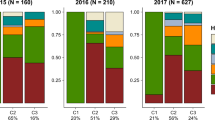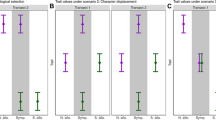Abstract
Speciation in herbivorous insects has received considerable attention during the last few decades. Much of this group’s diversity originates from adaptive population divergence onto different host plants, which often involves the evolution of specialized patterns of host choice behaviour. Differences in host choice often translates directly into divergence in mating sites, and therefore positive assortative mating will be created which will act as a strong barrier to gene flow. In this study, we first explored whether host choice is a genetically determined trait in the sympatric willow and birch host races of the leaf feeding beetle Lochmaea capreae, or whether larval experience influences adult host choice. Once we had established that host choice is a genetically based trait we determined its genetic architecture. To achieve this, we employed a reciprocal transplant design in which offspring from pure willow and birch cross-types, F1, F2 and backcrosses were raised on each host plant and their preference was determined upon reaching adulthood. We then applied joint-scaling analysis to uncover the genetic architecture of host preference. Our results suggest that rearing host does not have a pronounced effect on adult’s host choice; rather the segregation pattern implies the existence of genetic loci affecting host choice in these host races. The joint-scaling analysis revealed that population differences in host choice are mainly influenced by the contribution of additive genetic effects and also maternally inherited cytoplasmic effects. We explore the implications of our findings for evolutionary dynamics of sympatric host race formation and speciation.


Similar content being viewed by others
References
Barton K (2014) Package ‘MuMIn’: multi-model inference. R package version 1.9. 13
Bates D, Maechler M, Bolker B, Walker S (2013) lme4: linear mixed-effects models using Eigen and S4. R package version 1.0-5
Berlocher SH, Feder JL (2002) Sympatric speciation in phytophagous insects: Moving beyond controversy? Annu Rev Entomol 47:773–815
Bieri J, Kawecki TJ (2003) Genetic architecture of differences between populations of cowpea weevil (Callosobruchus maculatus) evolved in the same environment. Evolution 57:274–287
Burton RS, Rawson PD, Edmands S (1999) Genetic architecture of physiological phenotypes: empirical evidence for coadapted gene complexes. Am Zool 39:451–462
Bush GL (1969a) Mating behavior, host specificity, and the ecological significance of sibling species in frugivorous flies of the genus Rhagoletis (Diptera-Tephritidae). Am Nat 103:669–672
Bush GL (1969b) Sympatric host race formation and speciation in frugivorous flies of the genus Rhagoletis (Diptera, Tephritidae). Evolution 23:237–251
Caillaud M, Via S (2012) Quantitative genetics of feeding behavior in two ecological races of the pea aphid, Acyrthosiphon pisum. Heredity 108:211–218
Courtney SP, Chen GK, Gardner A (1989) A general model for individual host selection. Oikos 55:55–65
Coyne JA, Orr HA (2004) Speciation. Sinauer Associates, Sunderland
Craig TP, Horner JD, Itami JK (2001) Genetics, experience, and host plant preference in Eurosta solidaginis: implications for host shift and speciation. Evolution 55:773–782
Cruzan MB, Arnold ML (1999) Consequences of cytonuclear epistasis and assortative mating for the genetic structure of hybrid populations. Heredity 82:36–45
Dambroski HR, Linn C, Berlocher SH, Forbes AA, Roelofs W, Feder JL (2005) The genetic basis for fruit odor discrimination in Rhagoletis flies and its significance for sympatric host shifts. Evolution 59:1953–1964
Demuth JP, Wade MJ (2007) Population differentiation in the beetle Tribolium castaneum. I. Genetic architecture. Evolution 61:494–509
Desjardins CA, Perfectti F, Bartos JD, Enders LS, Werren JH (2010) The genetic basis of interspecies host preference differences in the model parasitoid Nasonia. Heredity 104:270–277
Dieckmann U, Doebeli M (1999) On the origin of species by sympatric speciation. Nature 400:354–357
Drès M, Mallet J (2002) Host races in plant–feeding insects and their importance in sympatric speciation. Philos Trans R Soc B 357:471–492
Emelianov I, Mallet J, Baltensweiler W (1995) Genetic differentiation in Zeiraphera diniana (Lepidoptera: Tortricidae, the larch budmoth): polymorphism, host races or. Heredity 75:16–424
Erwin TL (1982) Tropical forests: their richness in Coleoptera and other arthropod species. Coleop Bull 36:74–75
Falconer DS, Mackay TF, Frankham R (1996) Introduction to quantitative genetics (4th edn). Trends Genet 12:280
Feder JL, Forbes AA (2007) Habitat avoidance and speciation for phytophagous insect specialists. Funct Ecol 21:585–597
Forister ML (2005) Independent inheritance of preference and performance in hybrids between host races of Mitoura butterflies (Lepidoptera: Lycaenidae). Evolution 59:1149–1155
Funk DJ (1998) Isolating a role for natural selection in speciation: host adaptation and sexual isolation in Neochlamisus bebbianae leaf beetles. Evolution 52:1744–1759
Funk DJ (2012) Of “host forms” and host races: terminological issues in ecological speciation. Int J Ecol 2012:1–8
Funk DJ, Nosil P, Etges WJ (2006) Ecological divergence exhibits consistently positive associations with reproductive isolation across disparate taxa. Proc Natl Acad Sci USA 103:3209–3213
Funk DJ, Egan SP, Nosil P (2011) Isolation by adaptation in Neochlamisus leaf beetles: host-related selection promotes neutral genomic divergence. Mol Ecol 20:4671–4682
Futuyma DJ, Mitter C (1996) Insect-plant interactions: the evolution of component communities. Philos Trans R Soc B 351:1361–1366
Futuyma DJ, Keese MC, Scheffer SJ (1993) Genetic constraints and the phylogeny of insect–plant associations: responses of Ophraella communa (Coleoptera: Chrysomelidae) to host plants of its congeners. Evolution 47:888–905
Gassmann A, Levy A, Tran T, Futuyma D (2006) Adaptations of an insect to a novel host plant: a phylogenetic approach. Funct Ecol 20:478–485
Groman J, Pellmyr O (2000) Rapid evolution and specialization following host colonization in a yucca moth. J Evol Biol 13:223–236
Hawthorne DJ, Via S (2001) Genetic linkage of ecological specialization and reproductive isolation in pea aphids. Nature 412:904–907
Henniges-Janssen K, Reineke A, Heckel DG, Groot AT (2011) Complex inheritance of larval adaptation in Plutella xylostella to a novel host plant. Heredity 107:421–432
Huettel MD, Bush GL (1972) The genetics of host selection and its bearing on sympatric speciation in Procecidochares (Diptera: Tephritidae). Entomol Exp Appl 15:465–480
Hutter CM, Rand DM (1995) Competition between mitochondrial haplotypes in distinct nuclear genetic environments: Drosophila pseudoobscura vs D. persimilis. Genetics 140:537–548
Jaenike J (1990) Host specialization in phytophagous insects. Annu Rev Ecol Syst 21:243–273
Johnson PA, Hoppensteadt F, Smith JJ, Bush GL (1996) Conditions for sympatric speciation: a diploid model incorporating habitat fidelity and non-habitat assortative mating. Evol Ecol 10:187–205
Karpinski A, Haenniger S, Schöfl G, Heckel DG, Groot AT (2014) Host plant specialization in the generalist moth Heliothis virescens and the role of egg imprinting. Evol Ecol 28:1075–1093
Kreslavsky A, Mikheev A (1993) Gene gepghraphy of racial-differences in Lochmaeae capreae L (Coleoptera; Chrysomelidae), and the problem of sympatric speciation. Entomol Rev 72:50–58
Linn C, Feder JL, Nojima S, Dambroski HR, Berlocher SH, Roelofs W (2003) Fruit odor discrimination and sympatric host race formation in Rhagoletis. Proc Natl Acad Sci USA 100:11490–11493
Lynch M, Walsh B (1998) Genetics and analysis of quantitative traits. Sinauer, Sunderland
Mackay TF (2009) The genetic architecture of complex behaviors: lessons from Drosophila. Genetica 136:295–302
Malausa T, Bethenod M-T, Bontemps A, Bourguet D, Cornuet J-M, Ponsard S (2005) Assortative mating in sympatric host races of the European corn borer. Science 308:258–260
Mather K, Jinks JL (1971) Biometrical genetics. In: The study of continious variation. Cambridge University Press, Cambridge
Matsubayashi KW, Ohshima I, Nosil P (2010) Ecological speciation in phytophagous insects. Entomol Exp Appl 134:1–27
Matsuo T, Sugaya S, Yasukawa J, Aigaki T, Fuyama Y (2007) Odorant-binding proteins OBP57d and OBP57e affect taste perception and host-plant preference in Drosophila sechellia. PLoS Biol 5:e118
May RM, Beverton R (1990) How many species?[and discussion]. Philos Trans R Soc B 330:293–304
Meffert LM, Hicks SK, Regan JL (2002) Nonadditive genetic effects in animal behavior. Am Nat 160:S198–S213
Nosil P (2007) Divergent host plant adaptation and reproductive isolation between ecotypes of Timema cristinae walking sticks. Am Nat 169:151–162
Nygren G, Nylin S, Stefanescu C (2006) Genetics of host plant use and life history in the comma butterfly across Europe: varying modes of inheritance as a potential reproductive barrier. J Evol Biol 19:1882–1893
Oppenheim SJ, Gould F, Hopper KR (2012) The genetic architecture of a complex ecological trait: host plant use in the specialist moth, Heliothis subflexa. Evolution 66:3336–3351
Peccoud J, Simon J (2010) The pea aphid complex as a model of ecological speciation. Ecol Entomol 35:119–130
Rand DM, Clark AG, Kann LM (2001) Sexually antagonistic cytonuclear fitness interactions in Drosophila melanogaster. Genetics 159:173–187
Rice WR (1987) Speciation via habitat specialization: the evolution of reproductive isolation as a correlated character. Evol Ecol 1:301–314
Rundle HD, Nosil P (2005) Ecological speciation. Ecol Lett 8:336–352
Sackton TB, Haney RA, Rand DM (2003) Cytonuclear coadaptation in Drosophila: disruption of cytochrome c oxidase activity in backcross genotypes. Evolution 57:2315–2325
Schluter D (2000) The ecology of adaptive radiation. Oxford University Press, Oxford
Servedio MR, Van Doorn GS, Kopp M, Frame AM, Nosil P (2011) Magic traits in speciation: ‘magic’ but not rare? Trends Ecol Evol 26:389–397
Simpson GG (1955) Major features of evolution. Columbia University Press, New York
Sobel MS, Grace FC, Watt LR, Schemske DW (2009) The biology of speciation. Evolution 64:295–315
Soudi S, Reinhold K, Engqvist L (2015) Host associated divergence in sympatric host races of the leaf beetle Lochmaea capreae: implications for local adaptation and reproductive isolation. Biol J Linn Soc 116:169–182
Soudi S, Reinhold K, Engqvist L (2016) Ecologically dependent and intrinsic genetic signatures of postzygotic isolation between sympatric host races of the leaf beetle lochmaea capreae. Evolution. doi:10.1111/evo.12846
R Development Core Team (2012) R: a language and environment for statistical computing. R Foundation for Statistical Computing Vienna, Austria
Thompson JN (1988) Coevolution and alternative hypotheses on insect/plant interactions. Ecology 69:893–895
Via S (1999) Reproductive isolation between sympatric races of pea aphids. I. Gene flow restriction and habitat choice. Evolution 53:1446–1457
Wcislo WT (1989) Behavioral environments and evolutionary change. Annu Rev Ecol Syst 20:137–169
Willett CS, Burton RS (2004) Evolution of interacting proteins in the mitochondrial electron transport system in a marine copepod. Mol Biol Evol 21:443–453
Wolf JB, Wade MJ (2009) What are maternal effects (and what are they not)? Philos Trans R Soc B 364:1107–1115
Xue H-J, Magalhães S, Li W-Z, Yang X-K (2009) Reproductive barriers between two sympatric beetle species specialized on different host plants. J Evol Biol 22:2258–2266
Yoder J, Clancey E, Des Roches S, Eastman J, Gentry L, Godsoe W, Hagey T, Jochimsen D, Oswald B, Robertson J (2010) Ecological opportunity and the origin of adaptive radiations. J Evol Biol 23:1581–1596
Acknowledgments
We thank two anonymous reviewers for their helpful comments on previous versions.
Author information
Authors and Affiliations
Corresponding author
Ethics declarations
Conflict of interest
The authors declare that they have no competing interests.
Rights and permissions
About this article
Cite this article
Soudi, S., Reinhold, K. & Engqvist, L. Genetic architecture underlying host choice differentiation in the sympatric host races of Lochmaea capreae leaf beetles. Genetica 144, 147–156 (2016). https://doi.org/10.1007/s10709-016-9885-2
Received:
Accepted:
Published:
Issue Date:
DOI: https://doi.org/10.1007/s10709-016-9885-2




